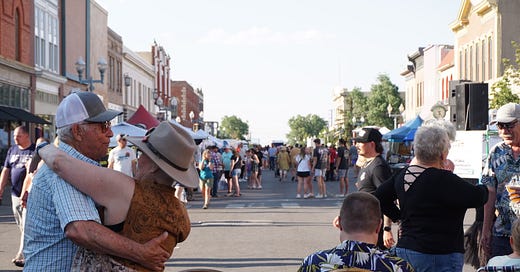[Retracted] With a high of 95, Laramie hit record temperatures Friday
On July 12, 1954, Laramie residents weathered a 93-degree afternoon. It was the hottest July 12 the city had ever seen. This year, the heat was even worse.

Retraction: This story stated Laramie had reached 95 degrees on July 12, 2024, which would have been an all-time high for any day in Laramie in addition to being an all-time high for July 12. However, the actual high was potentially a few degrees lower.
The error was the fault of National Weather Service sensors. Following an investigation some time later, NWS meteorologists say they can no longer confirm the high that day.
“We did have some issues going on with the temperature sensor at the airport at that time, so we determined that [record temp] was invalid,” Meteorologist Michael Natoli told the Laramie Reporter in June 2025. “So the old all-time record [for any day] of 94 degrees still stands.”
If the record definitively remained and only the numbers needed updating, this story would have been corrected. However, the Reporter can no longer stand by the assertion in this story’s headline, nor much of the body below supporting that headline. Many of the details below regarding historical temperatures, the science of climate change and the advent of air conditioning technology are themselves accurate. But the story’s central thesis — that on July 12, 2024, Laramigos survived record-setting heat — can no longer be verified to the standards of this publication.
The story will remain published, with this additional note, for posterity.
Laramie surpassed a 70-year heat record Friday, hitting 95 degrees on a day of the calendar that had never seen the Gem City of the Plains get so hot.
Previously, the hottest July 12 on record was in 1954, when Laramie folks watched the temps rise to 93 degrees.
“So it’s a long-standing record,” said Steve Rubin, a meteorologist with the National Weather Service in Cheyenne. “It’s been warm, as you know. Temperatures have been slowly climbing, from the low- to mid-80s. Now they’re in the mid-90s, which is pretty hot for Laramie.”
Laramigos are celebrating Jubilee Days this weekend, with street dancing and a carnival Thursday-Saturday and Downtown Laramie’s annual Brewfest today from 1:30-6 p.m. (Brewfest organizers are reminding attendees to “bring lots of water” and sunscreen.)
Laramie could even tie its heat record for July 13 as well, according to the National Weather Service’s forecast for today. But one way or another, and with one daily record already under its belt, the weekend has been and will continue to be significantly hotter than the average year.
For all days July 11-14, the average daily high is about 81 degrees.
On July 11 (Thursday), Laramie hit 92 degrees — 1 degree short of that calendar day’s record of 93, which occurred in both 1954 and 2013.
On July 12 (Friday), Laramie hit 95 degrees — 2 degrees above that calendar day’s record of 93, which occurred in 1954.
On July 13 (Saturday), Laramie is projected to hit a high of 90 degrees — tying that calendar day’s record, which occurred three years in a row, from 2003-2005.
On July 14 (Sunday), Laramie is projected to hit a high of 90 degrees, 1 degree short of that calendar day’s record of 91.
Is climate change to blame? Maybe. Anthropogenic climate change is not responsible for each individual hot day — nor even each record-setting day — but it is responsible for increasing the intensity and frequency of hot days.
“It’s really hard to say if it’s climate change,” Rubin said. “It’s a warm period, but it’s hard to say if it’s attributable to climate change.”
Both Wyoming and the city of Laramie should expect to see more record-setting highs in the coming years. Projections for both were highlighted in the city’s new Emissions Reduction Plan.
“The state of Wyoming is projected to experience increased risks to public health as a result of severe weather, including a greater frequency of extremely hot and cold days,” the plan notes. “Specifically, by 2050, Wyoming is likely to have twice as many days above 100°F as it has today. The City of Laramie, in particular, is considered to be at ‘high’ heat risk, and is projected to experience 36 hot days per year (i.e., days above 86°F) by 2050, as opposed to [the] 7 hot days per year that it traditionally experiences.”
Many homes in the typically cold Mountain West do not have or use air conditioning. When Laramie residents saw two back-to-back 93-degree days in July, 1954, fewer than 2 percent of all homes in the U.S. had air conditioning. The technology itself has existed for more than 100 years, but it was initially expensive and unwieldy. It wasn’t until the 1960s that most new homes were being built with AC units.




Not climate change???? Really! Man has had no impact on the planet??!